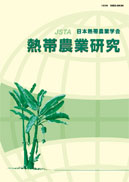Volume 4, Issue 2
Displaying 1-13 of 13 articles from this issue
- |<
- <
- 1
- >
- >|
Review Article
-
2011 Volume 4 Issue 2 Pages 67-82
Published: 2011
Released on J-STAGE: September 10, 2014
Download PDF (975K)
Original Article
-
2011 Volume 4 Issue 2 Pages 83-89
Published: 2011
Released on J-STAGE: September 10, 2014
Download PDF (1029K) -
2011 Volume 4 Issue 2 Pages 90-98
Published: 2011
Released on J-STAGE: September 10, 2014
Download PDF (1473K)
Symposium
-
2011 Volume 4 Issue 2 Pages 99
Published: 2011
Released on J-STAGE: September 10, 2014
Download PDF (191K) -
2011 Volume 4 Issue 2 Pages 100-108
Published: 2011
Released on J-STAGE: September 10, 2014
Download PDF (669K) -
2011 Volume 4 Issue 2 Pages 109-112
Published: 2011
Released on J-STAGE: September 10, 2014
Download PDF (141K) -
2011 Volume 4 Issue 2 Pages 113-119
Published: 2011
Released on J-STAGE: September 10, 2014
Download PDF (1167K) -
2011 Volume 4 Issue 2 Pages 120-125
Published: 2011
Released on J-STAGE: September 10, 2014
Download PDF (1225K) -
2011 Volume 4 Issue 2 Pages 126-132
Published: 2011
Released on J-STAGE: September 10, 2014
Download PDF (993K) -
2011 Volume 4 Issue 2 Pages 133-137
Published: 2011
Released on J-STAGE: September 10, 2014
Download PDF (848K) -
2011 Volume 4 Issue 2 Pages 138-142
Published: 2011
Released on J-STAGE: September 10, 2014
Download PDF (1221K) -
2011 Volume 4 Issue 2 Pages 143-144
Published: 2011
Released on J-STAGE: September 10, 2014
Download PDF (200K)
Research Meeting
-
Regional Cooperative Project of Animal Disease Control Planning and Control System in Southeast Asia2011 Volume 4 Issue 2 Pages 145-148
Published: 2011
Released on J-STAGE: September 10, 2014
Download PDF (434K)
- |<
- <
- 1
- >
- >|
